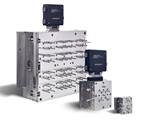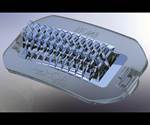Injection Molding: New Micro-Injection Unit for LSR
Engel and collaborator ACH Solution say the new unit enables shot weights well below 0.1 g.
Share
Read Next
As part of its live e-xperience (Oct. 13-16, read more), injection molding and automation supplier Engel is producing ophthalmology components with an individual part weight of just 0.0013g. An all-electric tiebarless Engel e鈥憁otion 50/30 TL press is equipped with the new LSR micro-injection unit, which Engel developed together with ACH Solution (Fischlham, Austria).
For the market launch, a the e-motion machine will run a 32-cavity valve gate cold runner mold producing connecting elements used in ophthalmic diagnostic instruments. The filigree parts measure 1.7 mm in length, 0.9 mm in diameter and weigh just 0.0013 g. The e-motion is equipped with an LSR metering pump by ACH Solution and an Engel viper 6 linear robot for micropart removal and conveyor belt placement. A camera system for quality control was also provided by ACH Solution.
Engel says flexibility was a key focus for the micro-injection unit. A quick coupling system means the unit can be exchanged for a conventional injection unit in less than 30 minutes, according to Engel.
The company also points out that the large platens of the tiebarless e-motion TL injection molding machine, which can be fully utilized right up to the edge because there are no tiebars to get in the way, lets the machine accommodate large, multiple-cavity molds on comparatively small injection molding machines.

The LSR components measure 1.7 mm in length and 0.9 mm in diameter and weigh just 0.0013 grams.
Related Content
-
Three Key Decisions for an Optimal Ejection System
When determining the best ejection option for a tool, molders must consider the ejector’s surface area, location and style.
-
Using Data to Pinpoint Cosmetic Defect Causes in Injection Molded Parts
Taking a step back and identifying the root cause of a cosmetic flaw can help molders focus on what corrective actions need to be taken.
-
Understanding the Effect of Pressure Losses on Injection Molded Parts
The compressibility of plastics as a class of materials means the pressure punched into the machine control and the pressure the melt experiences at the end of fill within the mold will be very different. What does this difference mean for process consistency and part quality?



